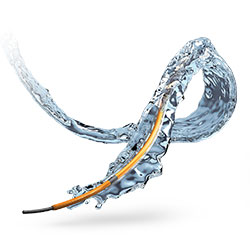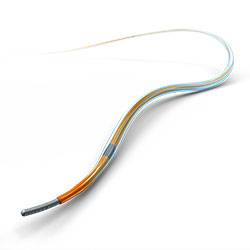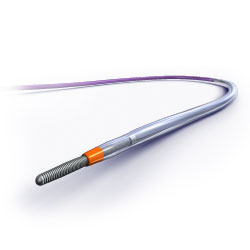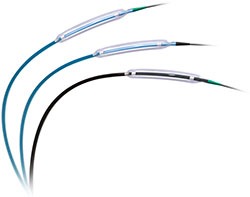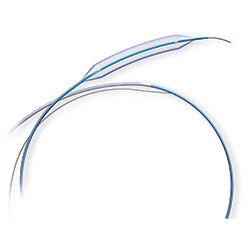Explore Abbott's Portfolio of Balloon Dilatation Catheters.
Armada™ 14 and Armada™ 14 XT Balloon Dilatation Catheter
- Catheter and balloon design combine flexibility and strength to prevent kinking
- Streamlined tip and a low-profile balloon designed for excellent lesion crossability
Armada™ 18 Balloon Dilatation Catheter
- Precision and effective applications for above and below the knee
- Balloon lengths from 20 mm to 200 mm
Armada™ 35 Balloon Dilatation Catheter
- Offers a broad portfolio with each size range engineered for specific clinical situations
- Balloon lengths from 20 mm to 250 mm
JADE‡ PTA Balloon Catheter
- The only non-compliant balloon platform available in all three guide wire compatible systems, .014, .018 and .035, on the U.S. market
- Available in 200 cm shaft lengths for radial access and balloon working lengths from 20mm-240mm
RX Viatrac™ 14 Plus Balloon Dilatation Catheter
- Rapid exchange delivery system for single-operator use and fast balloon exchanges
- Ideal for vascular arterial access and dilatation
Data on file at Abbott.
Manufactured by OrbusNeich Medical Group Holdings Limited or its affiliates. Distributed by Cardiovascular Systems, Inc. (CSI). CSI is a subsidiary of the Abbott Group of Companies.
JADE‡ and OrbusNeich are registered trademarks of OrbusNeich Medical Group Holdings Limited or its affiliates.
CAUTION: This OrbusNeich product is intended for use by or under the direction of a physician. Prior to use, reference the Instructions for Use at eifu.orbusneich.com for more detailed information on Indications, Contraindications, Warnings, Precautions, and Adverse Events.
MAT-2114542 v3.0
Armada™ 14
PTA Catheter

Indications
The device is indicated to dilate stenoses in femoral, popliteal, infra popliteal and renal arteries and for the treatment of obstructive lesions of native or synthetic arteriovenous dialysis fistulae. The 2.0 to 4.0 mm balloon diameters are also indicated for post-dilatation of balloon-expandable stents up to 40 mm and self-expanding stents up to 80 mm in the vessels listed above.
Contraindications
- Inability to cross lesion with a guide wire
- Use in the coronary arteries
Warnings / Precautions
- This device should only be used by physicians who are experienced and have a thorough understanding of the clinical and technical aspects of PTA.
- One-time use only – do not resterilize! This single use device cannot be reused on another patient, as it is not designed to perform as intended after the first usage. Changes in mechanical, physical, and/or chemical characteristics introduced under conditions of repeated use, cleaning, and/or resterilization may compromise the integrity of the design and/or materials, leading to contamination due to narrow gaps and/or spaces and diminished safety and/or performance of the device. Absence of original labeling may lead to misuse and eliminate traceability. Absence of original packaging may lead to device damage, loss of sterility, and risk of injury to patient and/or user.
- Do not use if inner package is damaged or opened.
- Employ aseptic techniques during removal from the package and during use.
- Any use for procedures other than those indicated in these instructions is not recommended.
- Use prior to the use by date.
- Carefully inspect the catheter prior to use to verify that it has not been damaged during shipment and that its size, shape and condition are suitable for the procedure for which it is to be used.
- Precautions to prevent or reduce blood clotting should be taken when any catheter is used.
- Flush or rinse all products entering the vascular system with sterile isotonic saline or a similar solution via the guide wire access port prior to use. Consider the use of systemic heparinization.
- When the system is introduced into the vascular system, it should be manipulated only under high quality fluoroscopy.
- The Armada™ 14 PTA Catheter must always be introduced, moved and or withdrawn over a guide wire (max. 0.014″).
- Never attempt to move the guide wire when the balloon is inflated.
- Never use air or any gaseous medium to inflate the balloon.
- Do not advance the Armada™ 14 PTA Catheter against significant resistance. The cause of resistance should be determined via fluoroscopy and remedial action taken.
- The minimal acceptable sheath French size is printed on the package label. Do not attempt to pass the Armada™ 14 PTA Catheter through a smaller sized sheath introducer than indicated on the label.
- The size of the inflated balloon should be selected not to exceed the diameter of the artery immediately distal, or proximal, to the stenosis.
- Inflation in excess of the rated burst pressure may cause the balloon to rupture. Use of a pressure monitoring device is recommended.
- If a distal protection device is used, follow the manufacturer’s instruction for use. Allow and maintain adequate distance between the Armada™ 14 PTA Catheter and the distal protection device to avoid engagement.
- Rated burst pressure and balloon fatigue testing of the Armada™ 14 PTA balloons within deployed stents has demonstrated the following:
- The 2.0 to 4.0 mm balloon diameters can safely post-dilate balloon expandable stents up to 40 mm in length.
- The 2.0 to 4.0 mm balloon diameters can safely post-dilate self-expanding stents up to 80 mm in length.
The safety of using additional balloon diameters and/or lengths to post dilate stents has not been established.
- When post-dilating stents, use a balloon length that is appropriate for the deployed stent length.
Potential Complications
The following complications may occur as a result of PTA, but may not be limited to:
- Abrupt closure
- Access site hematoma
- Aneurysm
- Angina
- Arrhythmias
- Arteriovenous fistula
- Bleeding complications which may require transfusion
- Cerebral ischemia/transient ischemic attack (TIA)
- Death
- Embolism (air, tissue, thrombotic, systemic or device component)
- Fever/pyrogenic reaction
- Hypersensitivity or allergic reaction to contrast agents and drug reactions
- Hypertension / hypotension
- Infection
- Ischemia, including tissue ischemia, steal syndrome and necrosis
- Leg edema
- Myocardial ischemia or infarction
- Nausea and vomiting
- Neuropathies or nerve injury
- Occlusion
- Organ failure (single, multiple)
- Pain
- Palpitations
- Pseudoaneurysm
- Renal failure/insufficiency
- Restenosis
- Stroke / cerebrovascular accident (CVA)
- Vascular complications, including entry site, which may require vessel repair
- Vascular thrombosis
- Vessel injury, e.g. dissection, perforation
- Vessel spasm
MAT-2114592 v2.0
Armada™ 14 XT
Percutaneous Transluminal Angioplasty (PTA) Catheter

Indications
The Armada™ 14 XT PTA Catheter is indicated to dilate stenosis in femoral, popliteal, infrapopliteal and renal arteries and for the treatment of obstructive lesions of native or synthetic arteriovenous dialysis fistulae. The 2.0 mm to 5.0 mm balloon diameters are also indicated for post-dilatation of stents in the peripheral vasculature.
Contraindications
The Armada™ 14 XT PTA Catheter is contraindicated for:
- Inability to cross lesion with a guide wire
Warnings
This device is intended for one time use only. DO NOT resterilize and / or reuse it, as this can compromise device performance and increase the risk of cross contamination due to inappropriate reprocessing.
Any use for procedures other than those indicated in these instructions is not recommended.
Precautions to prevent or reduce clotting should be taken when any catheter is used.
The size of the inflated balloon should be selected not to exceed the diameter of the artery immediately distal, or proximal, to the stenosis.
Balloon pressure should not exceed the rated burst pressure (RBP). The RBP is based on results of in vitro testing. At least 99.9% of the balloons (with a 95% confidence) will not burst at or below their RBP. Use of a pressure-monitoring device is recommended to prevent over- pressurization.
To reduce the potential for vessel damage, the inflated diameter of the balloon should approximate the diameter of the vessel just proximal and distal to the stenosis.
Do not use, or attempt to straighten, a catheter if the shaft has become bent or kinked; this may result in the shaft breaking. Instead, prepare a new catheter.
Do not torque the catheter more than one (1) full turn.
If a distal protection device is used, follow the manufacturer’s instruction for use. Allow and maintain adequate distance between the Armada™ 14 XT PTA Catheter and the distal protection device to avoid engagement.
Use only the recommended balloon inflation medium. Never use air or any gaseous medium to inflate the balloon.
When the catheter is exposed to the vascular system, it should be manipulated while under high quality fluoroscopic observation. Do not advance or retract the catheter unless the balloon is fully deflated under vacuum. If resistance is met during manipulation, determine the cause of resistance before proceeding.
Treatment of moderately or heavily calcified lesions increases the risk of acute closure, vessel trauma, balloon burst, balloon entrapment, and associated complications. If resistance is felt, determine the cause before proceeding. Continuing to advance or retract the catheter while under resistance may result in damage to the vessels and / or damage / separation of the catheter.
In the event of catheter damage / separation, recovery of any portion should be performed based on physician determination of individual patient condition and appropriate retrieval protocol.
In cases of extreme vessel tortuosity, it may be necessary to reposition the catheter in a straight segment of the vessel in order to allow guide wire exchange. Do not continue to use a catheter if excessive resistance is felt during guide wire exchanges. Instead, prepare a new catheter.
Precautions
This device should only be used by physicians who are experienced and have a thorough understanding of the clinical and technical aspects of PTA.
Note the “Use by” date specified on the package.
Inspect all product prior to use. Do not use if the package is open or damaged.
Prior to angioplasty, the PTA catheter should be examined to verify functionality and ensure that its size is suitable for the specific procedure for which is to be used.
Precautions to prevent or reduce clotting should be taken when any catheter is used.
Flush or rinse all products entering the vascular system with sterile heparinized normal saline or a similar solution via the guide wire access port prior to use. Consider the use of systemic heparinization.
Never attempt to move the guide wire when the balloon is inflated.
The minimal acceptable sheath / guiding catheter French size is printed on the package label. Do not attempt to pass the Armada™ 14 XT PTA Catheter through a smaller sized sheath / guiding catheter than indicated on the label.
If the surface of the Armada™ 14 XT PTA Catheter becomes dry, wetting with heparinized normal saline will reactivate the coating.
Do not reinsert the Armada™ 14 XT PTA Catheter into the coil dispenser after procedural use.
Bench testing was conducted with 0.014" (0.36 mm) constant diameter guide wires to establish guide wire compatibility. If another type of guide wire is selected with a different dimensional profile, the compatibility (e.g., wire resistance) should be considered prior to use.
The safety and effectiveness of this PTA balloon catheter for the treatment of in-stent restenosis (ISR) have not been established.
Adverse Events
Possible adverse effects include, but are not limited to, the following:
- Abrupt closure
- Access site hematoma
- Aneurysm
- Angina
- Arrhythmias
- Arteriovenous fistula
- Bleeding complications which may require transfusion
- Cerebral ischemia / transient ischemic attack (TIA)
- Death
- Embolism (air, tissue, thrombotic, systemic or device component)
- Fever/pyrogenic reaction
- Hypersensitivity or allergic reaction to contrast agents and drug reactions
- Hypertension / hypotension
- Infection
- Ischemia, including tissue ischemia, steal syndrome and necrosis
- Leg edema
- Myocardial ischemia or infarction
- Nausea and vomiting
- Neuropathies or nerve injury
- Occlusion
- Organ failure (single, multiple)
- Pain
- Palpitations
- Pseudoaneurysm
- Renal failure / insufficiency
- Restenosis
- Stroke / cerebrovascular accident (CVA)
- Vascular complications, including entry site, which may require vessel repair
- Vascular thrombosis
- Vessel injury, e.g. dissection, perforation
- Vessel spasm
MAT-2114593 v2.0
Armada™ 18 Percutaneous Transluminal Angioplasty (PTA) Catheter

Indications
The Armada™ 18 is indicated to dilate stenosis in femoral, popliteal, infra-popliteal, and renal arteries and for the treatment of obstructive lesions of native or synthetic arteriovenous dialysis fistulae. In addition, the device is also indicated for post-dilatation of balloon expandable and self-expanding stents.
Contraindications
- Inability to cross lesion with a guide wire
- Use in the coronary arteries
Warnings / Precautions
- This device should only be used by physicians who are experienced and have a thorough understanding of the clinical and technical aspects of PTA.
- One-time use only – do not resterilize! This single use device cannot be reused on another patient, as it is not designed to perform as intended after the first usage. Changes in mechanical, physical, and / or chemical characteristics introduced under conditions of repeated use, cleaning, and/ or resterilization may compromise the integrity of the design and / or materials, leading to contamination due to narrow gaps and / or spaces and diminished safety and / or performance of the device. Absence of original labeling may lead to misuse and eliminate traceability. Absence of original packaging may lead to device damage, loss of sterility, and risk of injury to patient and / or user.
- Do not use if inner package is damaged or opened.
- Employ aseptic techniques during removal from the package and during use.
- Any use for procedures other than those indicated in these instructions is not recommended.
- Use prior to the use by date.
- Carefully inspect the catheter prior to use to verify that it has not been damaged during shipment and that its size, shape and condition are suitable for the procedure for which it is to be used.
- Precautions to prevent or reduce blood clotting should be taken when any catheter is used.
- Flush or rinse all products entering the vascular system with sterile isotonic saline or a similar solution via the guide wire access port prior to use. Consider the use of systemic heparinization.
- When the system is introduced into the vascular system, it should be manipulated only under high quality fluoroscopy.
- The Armada™ 18 PTA Catheter must always be introduced, moved and or withdrawn over a guide wire (max. 0.018″).
- Never attempt to move the guide wire when the balloon is inflated.
- Never use air or any gaseous medium to inflate the balloon.
- Do not advance the Armada™ 18 PTA Catheter against significant resistance. The cause of resistance should be determined via fluoroscopy and remedial action taken.
- The minimal acceptable sheath French size is printed on the package label. Do not attempt to pass the Armada™ 18 PTA Catheter through a smaller sized sheath introducer than indicated on the label.
- The size of the inflated balloon should be selected not to exceed the diameter of the artery immediately distal, or proximal, to the stenosis.
- Inflation in excess of the rated burst pressure may cause the balloon to rupture. Use of a pressure monitoring device is recommended.
- If a distal protection device is used, follow the manufacturer’s instruction for use. Allow and maintain adequate distance between the Armada™ 18 PTA Catheter and the distal protection device to avoid engagement.
- Rated burst pressure and balloon fatigue testing of the Armada™ 18 PTA balloons within deployed stents has demonstrated that the Armada™ 18 can safely post-dilate balloon expandable and self-expanding stents.
- When post-dilating stents, use a balloon length that is appropriate for the deployed stent length.
Potential Complications
The following complications may occur as a result of PTA, but may not be limited to:
- Abrupt closure
- Allergic reaction (contrast medium, drug, or stent material)
- Aneurysm, pseudoaneurysm or arteriovenous fistula
- Angina or coronary ischemia
- Arrhythmias (including premature beats, bradycardia, atrial or ventricle tachycardia, atrial or ventricular fibrillation)
- Bleeding complications requiring transfusion or surgical intervention
- Death
- Detachment and / or implantation of a component of the system
- Embolization, arterial or other (air, tissue, plaque, thrombotic material, device)
- Emergent or urgent surgery
- Fever
- Hematoma or hemorrhagic event with or without surgical repair
- Hyperperfusion syndrome
- Hypotension or hypertension
- Infection
- Ischemia or infarction of tissue or organ not covered under other adverse events
- Myocardial infarction
- Pain (limb or catheter site)
- Peripheral nerve injury
- Pulmonary embolism
- Renal failure or insufficiency
- Restenosis of vessel
- Shock
- Stroke, cerebrovascular accident (CVA), or transient ischemic attack (TIA)
- Target limb loss (amputation of toe, foot, and / or leg)
- Vascular thrombosis or occlusion at puncture site, treatment site, or remote site
- Venous thromboembolism
- Vessel dissection, perforation, or rupture
- Vessel spasm or recoil
- Worsening claudication or rest pain
MAT-2114595 v2.0
Armada™ 35 / Armada™ 35 LL
Percutaneous Transluminal Angioplasty (PTA) Catheter

Indications
The device is intended for dilatation of lesions in the renal, iliac, femoral, popliteal, tibial, and peroneal arteries and for the treatment of obstructive lesions of native or synthetic arteriovenous dialysis fistulae.
This device is also indicated for stent post-dilatation in the peripheral vasculature.
Contraindications
- Inability to cross lesion with a guide wire
- Use in the coronary arteries
Warnings / Precautions
- This device should only be used by physicians who are experienced and have a thorough understanding of the clinical and technical aspects of PTA.
- One-time use only – do not resterilize! This single use device cannot be reused on another patient, as it is not designed to perform as intended after the first usage. Changes in mechanical, physical, and/or chemical characteristics introduced under conditions of repeated use, cleaning, and/or resterilization may compromise the integrity of the design and/or materials, leading to contamination due to narrow gaps and/or spaces and diminished safety and/or performance of the device. Absence of original labeling may lead to misuse and eliminate traceability. Absence of original packaging may lead to device damage, loss of sterility, and risk of injury to patient and/or user.
- Do not use if inner package is damaged or opened.
- Employ aseptic techniques during removal from the package and during use.
- Any use for procedures other than those indicated in these instructions is not recommended.
- Use prior to the use by date.
- Carefully inspect the catheter prior to use to verify that it has not been damaged during shipment and that its size, shape and condition are suitable for the procedure for which it is to be used.
- Precautions to prevent or reduce blood clotting should be taken when any catheter is used.
- Flush or rinse all products entering the vascular system with sterile isotonic saline or a similar solution via the guide wire access port prior to use.
- Consider the use of systemic heparinization.
- When the system is introduced into the vascular system, it should be manipulated only under high quality fluoroscopy.
- The Armada™ 35 / Armada™ 35 LL PTA Catheter must always be introduced, moved and or withdrawn over a guide wire (max. 0.035”).
- Never attempt to move the guide wire when the balloon is inflated.
- Never use air or any gaseous medium to inflate the balloon.
- Do not advance the Armada™ 35 / Armada™ 35 LL PTA Catheter against significant resistance. The cause of resistance should be determined via fluoroscopy and remedial action taken.
- The minimal acceptable sheath French size is printed on the package label. Do not attempt to pass the Armada™ 35 / Armada™ 35 LL PTA Catheter through a smaller sized sheath introducer than indicated on the label.
- The size of the inflated balloon should be selected not to exceed the diameter of the artery immediately distal, or proximal, to the stenosis.
- Inflation in excess of the rated burst pressure may cause the balloon to rupture. Use of a pressure monitoring device is recommended.
- When post-dilating stents, use a balloon length that is appropriate for the deployed stent length.
Potential Complications
The following complications may occur as a result of PTA, but may not be limited to:
- Abrupt closure
- Allergic reaction (contrast medium, drug, or device material)
- Aneurysm or pseudoaneurysm in vessel, or at vascular access site
- Angina or coronary ischemia
- Arrhythmias (including premature beats, bradycardia, atrial or ventricular tachycardia, arterial or ventricular fibrillation)
- Arteriovenous fistula
- Bleeding complications requiring transfusion or surgical intervention
- Death
- Detachment of a system component or implantation in an unintended site
- Embolization (air, tissue, plaque, thrombotic material, device)
- Emergent surgery
- Fever
- Hematoma or hemorrhagic event, with or without surgical repair
- Hyperperfusion syndrome
- Hypotension or hypertension
- Infection
- Ischemia or infarction not covered under adverse events
- Myocardial infarction
- Pain (leg, foot, and / or insertion site)
- Peripheral nerve injury
- Pulmonary embolism
- Renal failure or insufficiency
- Restenosis
- Shock
- Stroke
- Target limb loss (amputation of toe, foot, and / or leg)
- Thrombosis or occlusion
- Transient ischemic attack
- Venous thrombosis
- Vessel dissection, perforation, or rupture
- Vessel spasm or recoil
- Worsening claudication or rest pain
MAT-2114594 v2.0
JADE‡ Rx, JADE‡ 014, JADE‡ 018, and JADE‡ 035
PTA Balloon Dilatation Catheters

INDICATIONS
The JADE‡ PTA Balloon Dilation Catheter is indicated for Percutaneous Transluminal Angioplasty in the peripheral vasculature, including iliac, femoral, iliofemoral, popliteal, infra-popliteal, and renal arteries, and for the treatment of obstructive lesions of native or synthetic arteriovenous dialysis fistulae. This device is also indicated for post-dilation of balloon expandable and self-expanding stents in the peripheral vasculature.
CONTRAINDICATIONS
The use of the JADE‡ PTA Balloon Dilatation Catheter is contraindicated:
- For use in the coronary or neuro vasculature.
- Where there is the inability to cross the target lesion with a guidewire.
WARNINGS
When using this type of device, the following warnings should be observed:
- This device is intended for single use only. Do not resterilize and/or reuse, as this can potentially result in compromised device performance and increased risk of cross-contamination.
- When the catheter is exposed to the vascular system, it should be manipulated while under high-quality fluoroscopic observation. Do not advance or retract the catheter unless the balloon is fully deflated under vacuum. If resistance is met during manipulation, determine the cause of the resistance before proceeding. Applying excessive force to the catheter can result in separation of the tip or balloon.
- To reduce the potential for vessel damage, the inflated diameter of the balloon should approximate the diameter of the vessel just proximal and distal to the stenosis.
- Balloon pressure should not exceed the rated burst pressure (RBP) indicated on the package. The rated burst pressure is based on the results of in vitro testing. At least 99.9 percent of the balloons, (with at least 95 percent confidence) will not burst at or below the rated burst pressure. Use of a pressure monitoring device is recommended to prevent over pressurization.
- To reduce the potential for air embolus into the vessel, use only the recommended balloon inflation medium. Never use air or any gaseous medium to inflate the balloon.
- For the rapid exchange catheters, do not re-straighten a kinked hypotube; straightening a kinked metal shaft may result in breakage of the shaft.
PRECAUTIONS
- The catheter system should be used only by physicians trained in percutaneous transluminal angioplasty.
- Use the catheter prior to the “Use By" date specified on the package.
- Prior to angioplasty, the catheter should be examined to verify functionality and ensure that its size and shape are suitable for the specific procedure for which it is to be used.
- Do not use oil-based contrast medium, organic solvents or alcohols; there is a possibility of catheter leak, damage or lubrication loss.
- The balloon deflation time has been established as 30 seconds (for 0.014” Rx) and 60 seconds (for 0.014”, 0.018”, and 0.035” OTW catheters) based on in vitro bench testing results.
- Use with caution for procedures involving calcified lesions or synthetic vascular grafts due to the abrasive nature of these lesions.
- Do not reinsert the PTA catheter into the coil dispenser after procedural use.
- Discard all disposable devices used during this procedure per local requirements for medical device waste disposal.
ADVERSE EFFECTS
Adverse effects due to the use of this product include, but are not limited to, the following:
- Acute or subacute thrombosis
- Acute vessel closure
- Allergic reaction to device, contrast medium, or medication
- Aneurysm
- Arrhythmias
- Arteriovenous fistula
- Death
- Dissection (perforation, rupture, or injury) of the vessel
- Hemorrhage or hematoma
- Hypertension
- Hypotension
- Infection
- Occlusion of the artery
- Restenosis of the dilated vessel
- Stroke, air embolism and embolization of fragmentation of thrombotic or atherosclerotic material
MAT-2400998 v2.0
Viatrac™ 14 Plus
Percutaneous Dilatation Catheters

Indications
The Viatrac™ 14 Plus Peripheral Dilatation Catheter is intended:
- To dilate stenosis in the peripheral arteries (iliac, femoral, ilio-femoral, popliteal, infra popliteal, renal arteries).
- For the treatment of obstructive lesions of native or synthetic arteriovenous dialysis fistulae.
Contraindications
None known for percutaneous transluminal angioplasty (PTA).
Warnings
The Viatrac™ 14 Plus Peripheral Dilatation Catheter is not intended for use in the coronary arteries.
This device is intended for one-time use only. DO NOT resterilize and / or reuse it, as this can compromise device performance and increase the risk of cross contamination due to inappropriate reprocessing.
To reduce the potential for vessel damage, the inflated diameter of the balloon should approximate the diameter of the vessel just proximal and distal to the stenosis.
When the catheter is exposed to the vascular system, it should be manipulated while under high-quality fluoroscopic observation. Do not advance or retract the catheter unless the balloon is fully deflated under vacuum. If resistance is met during manipulation, determine the cause of the resistance before proceeding.
Balloon pressure should not exceed the rated burst pressure (RBP). Refer to the product label for device specific information. The RBP is based on results of in vitro testing. At least 99.9% of the balloons (with a 95% confidence) will not burst at or below their RBP. Use of a pressure monitoring device is recommended to prevent over-pressurization.
Use only the recommended balloon inflation medium. Never use air or any gaseous medium to inflate the balloon.
Use the catheter prior to the “Use by” date specified on the package.
Do not use, or attempt to straighten, a catheter if the shaft has become bent or kinked, as this may result in the shaft breaking. Instead, prepare a new catheter.
Precautions
A thorough understanding of the principles, clinical applications, and risks associated with percutaneous transluminal angioplasty (PTA) is necessary before using this product.
Any use for procedures other than those indicated in these instructions is not recommended.
This device is not recommended for use in lesions that may require inflation higher than those recommended for this catheter.
Do not use if package is open or damaged.
Prior to angioplasty, the catheter should be examined to verify functionality and ensure that its size and shape are suitable for the specific procedure for which it is to be used.
During the procedure, appropriate anticoagulant therapy must be provided to the patient as needed. Anticoagulant therapy should be continued for a period of time to be determined by the physician after the procedure.
Shaft diameter differences should be taken into consideration when opening and tightening the hemostatic valve and upon withdrawal of the catheter.
It is important that the hemostatic valve (if used) is closed tightly enough to prevent blood leakage around the catheter shaft, yet not so tightly that it restricts the flow of contrast into and out of the balloon or restricts guide wire movement.
Adverse Events
Possible adverse events include but are not limited to:
- Abrupt closure
- Allergic reaction (contrast medium; drug; device material)
- Amputation or limb loss
- Aneurysm or pseudoaneurysm in vessel or at vascular access site
- Angina or coronary ischemia
- Arrhythmia (including premature beats, bradycardia, atrial or ventricular tachycardia, atrial or ventricular fibrillation)
- Arteriovenous fistula
- Bleeding complications requiring transfusion or surgical intervention
- Death
- Detachment of a system component or implantation in an unintended site
- Dialysis
- Embolization (air, tissue, plaque, thrombotic material, device)
- Emergent / urgent surgery
- Fever
- Heart failure
- Hematoma or hemorrhagic event, with or without surgical repair
- Hyperperfusion syndrome
- Hypotension / hypertension
- Infection
- Ischemia or infarction not covered under other AEs
- Myocardial infarction
- Pain (leg, foot, and / or insertion site)
- Peripheral nerve injury
- Pulmonary embolism
- Renal failure or insufficiency
- Restenosis
- Shock
- Stent malapposition or migration, which may require emergency surgery to remove stent
- Stent strut fracture
- Stroke
- Thrombosis or occlusion
- Tissue necrosis or ulceration
- Transient ischemic attack
- Venous thromboembolism
- Vessel dissection, perforation or rupture
- Vessel spasm or recoil
- Worsening claudication or rest pain
MAT-2114532 v2.0

